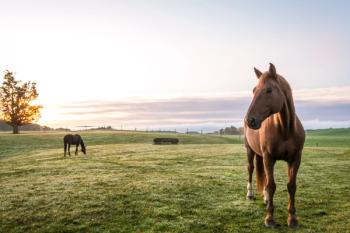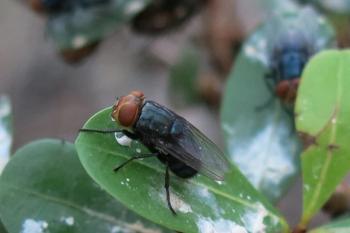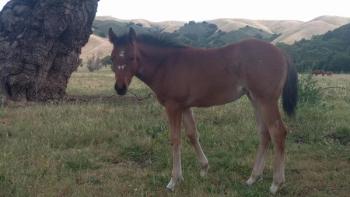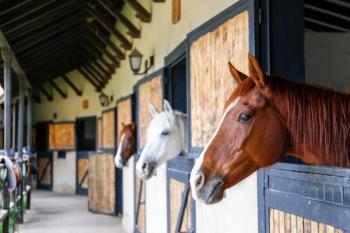
Minature medicine poses big distinctions
Reproduction is the area where mini owners are most likely to need veterinary assistance.
Trying to offer more professional services to your clients and trying to boost your bottom line is no small task. Yet sometimes a small thing can be just what is needed — 34 inches small to be exact. That is the height limit for animals registered with the American Miniature Horse Association (AMHA), and these diminutive equines represent an increasingly popular segment of the horse population and a potential new source of business for many practitioners.
Foaling is generally more difficult in miniatures than in full-size horses. The small size of the mare does not allow for much manipulation and the potential for malformations, especially of the head (above), neck and forelegs of the foal, can make deliveries challenging. Observation is crucial and some assistance is almost always needed. Veterinarians should be sure that their mini breeders are aware of and use some of the foaling monitoring systems and devices that are available. Experienced help should be on hand for the delivery, and a procedure for obtaining quick veterinary assistance should be discussed prior to the delivery date. Dystocias must be dealt with rapidly or unfortunate results are much more likely to occur.
It is very important, however, that veterinarians become educated about these potential patients because they are substantially different from full-size horses, and their care and management present unique challenges to the practitioner. Additionally, these small horses are attractive to first-time horse owners. Miniatures are popular with older clients and with clients who have reduced acreage but who want the equine experience. Many of these owners lack the husbandry skills needed to care for them. They are neither small horses nor large dogs but are commonly treated as such by many owners. Good knowledgeable veterinary care is critically needed for these clients.
The miniature horse is believed to have developed from a number of separate sources. A version of this animal was selectively bred and developed in Argentina where they are referred to as Falabellas. The Falabella family began breeding these horses in 1868, and it is believed that Shetland ponies were crossed with Criollo and Petizo animals, both Argentinean ponies. The Falabella pony is not a separate breed but rather a different type of miniature that developed from similar genetics in an isolated locale. There is, however, a separate Falabella registry.
Dwarfism or achondroplasia is believed to be an autosomal dominant condition that is commonly seen in some miniatures. Associated malformations can occur in the feet and legs, head and face or in the teeth and bones of the jaws.
The American Miniature Horse (AMH) actually evolved from more European roots, and historical records dating as far back as 1650 mention a vast zoo at the Palace of Versailles where King Louis XIV (the Sun King) kept a large number of interesting and exotic animals. Chief among these was a small herd of equally small horses. These horses were believed to have developed primarily from Shetland ponies that were selectively bred for small size and then were cross bred to ponies of other types. In fact, so much other blood went into producing the American Miniature Horse that only 60 of the original 209 miniature horses registered in the first AMH Stud Book in 1972 were listed as having any known parentage. Fourteen of the original 60 were sired by registered Shetlands.
Risks and variations
Though these miniatures are largely Shetland derived, the constant breeding decisions designed to produce small size, have lead to significant differences between minis and other pony breeds. Veterinarians treating miniatures should be aware that biochemical values for some blood parameters are significantly different between miniatures (AMH) and full-size horses (FSH). Minis tend to have fewer red blood cells, lower hemoglobin and reduced overall PVC (See Table 1). They have lower T3 and T4 levels naturally and also seem to have a higher incidence of hypothyroidism than seen in FSH. Serum potassium is normally elevated in minis.
Table 1. Clinical biochemical values for american miniature horses(Amh) and full-size horses (fsh)
Miniature horses grow a proportionately thicker and longer coat in the winter compared to most other horse breeds. Therefore, they need substantial protein content in their diets during these months. Nutrition in the miniature is challenging because these special horses have certain unique dietary needs, but they are volume limited and must not be overfed. Hepatic lipidosis can be a significant problem in miniatures, though it is relatively rare in the general horse population, according to Dr. Terry Gerros of Salem, Ore. Gerros says stressful conditions — such as transport, showing and recent foaling, along with improper diet — can predispose to hyperlipemia and should be avoided by feeding miniatures a lower-calorie and higher-fiber diet.
Miniatures seem to be poor drinkers in general, and many breeders comment that adequate water intake, though one of the most basic concepts in equine nutrition, is very important in these horses. Remind your clients to be sure that all of their minis, even the smallest, have easy access to fresh water sources. Because of this tendency to reduce fluid intake, miniatures are more prone to fecoliths or enteroliths compared to full-size horses. This problem and potential diagnosis always should be on the mind of a clinician presented with a miniature exhibiting signs of colic.
Newsbreak
Also, potentially contributing to feco-liths and colic are problems with dentition that results in poor chewing. Miniatures have large teeth for their proportionately small jaws, and many miniatures often exhibit various degrees of dwarfism, which can affect the orientation of the teeth and the bones of the jaw. Routine dental examinations and correct management can improve the health and longevity of miniatures significantly. Healthy and well-cared-for miniatures are among the longest lived of all equine breeds; a mini named Angel, which lived at the Horse Protection Society of North Carolina, survived for 50 years with good veterinary care. Miniature hand floats are available from many companies, as well as attachments for power equipment, that work in the small mouths of miniatures.
Deworming programs are very important in miniatures because intestinal parasites grow to the same size even though they are living in a much smaller host. Proportionally then, miniatures are at greatest risk from intestinal parasites, and solid deworming programs should be strictly adhered to. Clients should try to use good weight estimations, with assistance from a veterinarian if needed, when deworming to avoid under dosing, with resultant poor worm control, and overdosing, with potentially dangerous medical consequences. Daily dewormers work well in miniatures and because of their small size, such a daily program along with periodic rotational paste can be efficient, effective and economical.
These miniatures show the typical domed head and shortened face that characterize dwarfism in the breed.
Reproduction and vaccinations
Another interesting variation in miniatures involves the descent of testicles in stallions. Most full-size horses are considered cryptorchid or "retained" if the testicles have not dropped or descended into the scrotum after the first year. Dr. J.E. Cox PhD, chairman of Equine Studies at the University of Liverpool (England) has described a condition termed Temporary Inguinal Retention that is observed in small ponies and miniatures. This condition is characterized by small testis that can grow and ultimately descend into the scrotum by the time the animal is 3 years old. This parallels the experiences of many mini breeders who have seen similar situations among their horses. Veterinarians should be aware of this possible variation in miniatures so they can advise their clients accordingly.
This normal foal and normal herd are the result of diligent veterinary care and conscientious owners. Veterinarians should see miniature patients twice a year.
Vaccination recommendations are comparable to those for FSH. Dr. Elizabeth Metcalf, a theriogenologist in Sherwood, Ore., who has extensive experience with miniatures, cautions: "Be sure to use the full equine dose of vaccines, especially for killed Rhinopneumonitis in pregnant miniatures since there have been recorded abortion problems when a reduced dosage was attempted."
Metcalf also mentioned a few of the many differences seen in mini reproduction and some of the problem areas as well.
"The sperm of miniature horses is actually smaller than that of FSH," Metcalf says. "But there is no real difference in follicular size and development toward ovulation between mini mares and fullsized mares."
Reproduction is, in fact, the area where mini owners are most likely to need veterinary assistance. Metcalf reports a late-term abortion rate of almost 25 percent, in her clinical experience, compared to 12 percent for FSH.
"This increased abortion rate is largely due to a maternal/fetal mismatch or imbalance since the mare is often carrying a fetus that is disproportionally larger than her uterus," Metcalf explains.
There is simply not enough room, and a placentitis and resulting abortion often occur.
Those miniature mares that do go to full term frequently require veterinary assistance at delivery. The general rule is to breed a larger mare to a smaller stallion, but the quest for smaller and smaller foals can result in many problem deliveries. Veterinarians should strongly advise their clients to be sure that their mare's foaling is definitely observed, and oftentimes, it is advisable to have the mare at a location where assistance can be given quickly if needed.
Foaling detection devices are very useful for miniature clients and can be the difference in a live or dead foal. Because foaling is such a risky and important time for miniatures, it becomes crucial to have accurate breeding dates. Unfortunately many minis are bred naturally at pasture, and many veterinarians are understandably reluctant to perform ultrasound examinations to ascertain exact pregnancy dates. Additionally, the lack of routine ultrasound examination results in many missed reproductive problems, such as persistent Corpora Luteum, uterine infections, cysts and any number of other conditions that currently are handled routinely in FSH through the use of ultrasound.
An article in Equine Practice in May, 1992 explained the use of an ultrasound probe sleeve made from a plastic bovine pill gun. This sleeve can be adapted to fit most ultrasound probes, and it can then be used to introduce only the ultrasound probe rectally into the smallest of miniatures. Some practice is required, but this technique will allow clinicians to perform ultrasound examinations on miniatures to determine ovulation, pregnancy and all of the other information currently available to practitioners working with FSH. Once exact breeding dates are established, it becomes easier to anticipate delivery, and fewer lost foals may result.
Abnormalities
Even with the best of management, difficult deliveries can result largely because of the potential for dwarfism characteristics in miniatures. In an article in the American Miniature Horse magazine, Barbara Ashly writes: "Any breed of animal that attempts to reduce size has to accept dwarfism as an unwanted byproduct."
Other scholars dispute this claim, pointing out that the Dartmoor Pony, while closely comparable in size to miniatures, lacks any history of dwarfism problems. Regardless of the cause, it is all too certain that the American Miniature Horse has developed as a breed that currently contains a significant amount of dwarfism in its genetics.
Bond Tiny Tim was a 19-inch-tall miniature registered by the AMHA, and though he reportedly suffered from a number of dwarfism-related health issues, he was bred extensively allowing those defects to be passed on to thousands of descendants. Since 1989, however, the AMHA has refused registration to any miniature showing two or more dwarfism characteristics in an attempt to reduce the influence of these potentially damaging genes in the population.
There are more than 200 variations of dwarfism characteristics that have been cataloged and described in humans alone. Many of these have been proven to be genetic. Such proof is currently lacking in horses, but the wide variation of dwarfism characteristics is also seen in horses. Achondroplastic dwarfs unusually have short legs that often exhibit varus or valgus deformities. Deformities of the face and jaw are common with an undershot jaw most frequently seen. Brachycephalic dwarfs have large bulging foreheads and excess concavity or "dish" to the face. These minis have long heads and short, thick necks. All types of dwarfs can have abnormalities to the hooves and teeth as well. An AMHA-approved grant in 1991 to the veterinary genetics laboratory at the University of California-Davis was the first such full-scale attempt to investigate and determine the cause of dwarfism in miniatures. This research looked at the effect of dystrophic dwarfism on various collagen genes, insulin-like growth factor, growth hormone, and growth hormone-releasing factor and receptor. Important progress was made, but this area of research needs more time and much more funding before the intricacies of dwarfism in the horse are fully explained.
Veterinarians often first encounter dwarfism problems during delivery as the domed forehead and enlarged skull of brachycephalic dwarfs often causes problems as the fetus passes through the birth canal. Abnormalities of the legs and tendon contracture can cause positioning problems that will also result in dystocias. Time spent advising owners about good breeding choices will be well rewarded if fewer foaling problems are encountered and fewer genetic abnormalities are produced.
Overall, miniature horses require a level of care and management that often exceeds that of full-size horses, and yet, they are most commonly owned by clients that have not yet developed a sufficient level of equine husbandry skill. Veterinarians are in a unique position to offer advice and veterinary care to these often very motivated clients. Dental care and maintenance should be done on a regular basis, often twice each year. Dietary consultation is important and can help to avoid many potential medical conditions. Reproduction in the miniature horse can be a large source of potential problems, but it also can be a new source of practice income if done properly. Ultrasound can be used effectively in miniatures and can lead to fewer problems, more healthy foals on the ground and more satisfied clients. Ultimately, interest and expertise in miniature horse care can be a practice builder for equine veterinarians and that, in itself, is no small thing.
Dr. Marcella, a 1983 graduate of Cornell University's veterinary college, was a professor of comparative medicine at the University of Virginia. His interests include muscle problems in sport horses, rehabilitation and other performance issues.
Newsletter
From exam room tips to practice management insights, get trusted veterinary news delivered straight to your inbox—subscribe to dvm360.






